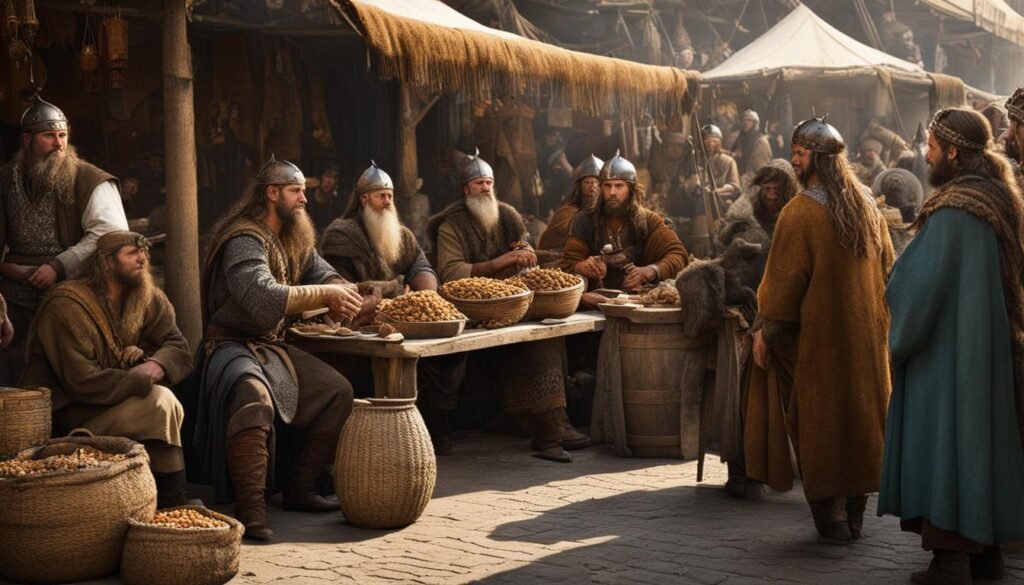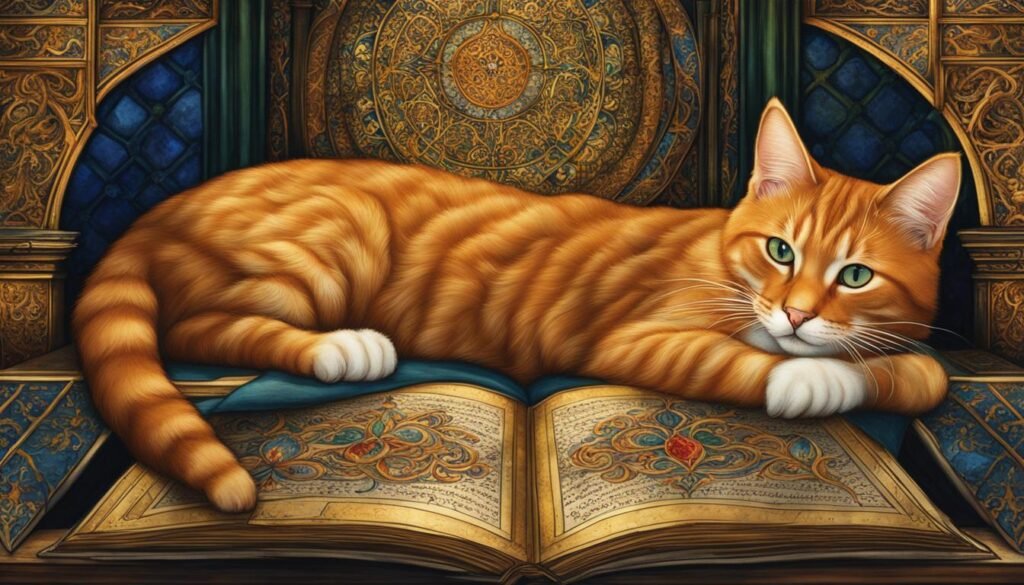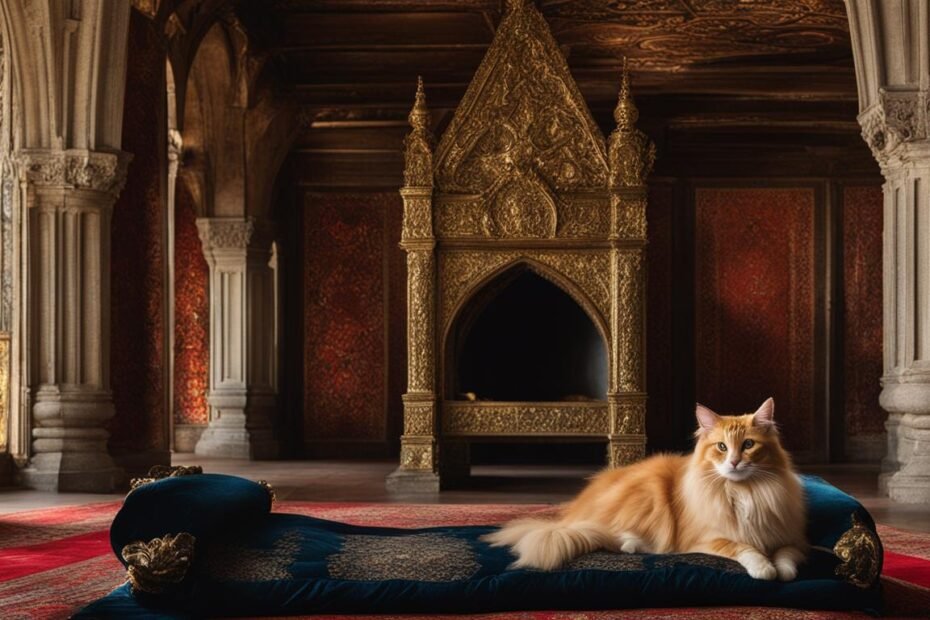Welcome to a journey back in time to explore the captivating world of cats in medieval Europe. In this article, we delve into the fascinating role these furry companions played in the daily lives of people during the Middle Ages. Despite their complicated reputation due to associations with paganism and witchcraft, cats were cherished members of medieval European households.
Medieval manuscripts provide us with a window into the lives of these enchanting creatures. Images of cats in domestic spaces depict them as lovingly cared for pets, often found alongside high-status individuals. As symbols of wealth and elevated social standing, cats were given names and provided with special food and accessories.
Not limited to households, cats also found their place in the hearts of scholars. They were celebrated as beloved companions and even featured in poems. In religious spaces, cats served as status symbols, although they also faced criticism in medieval sermon literature.
Key Takeaways:
- Medieval Europe Cats were an integral part of daily life in the Middle Ages.
- They were depicted in manuscripts, portraits, and religious spaces, symbolizing status and companionship.
- Cats were cherished companions to scholars, providing comfort and distractions.
- Despite negative associations, cats were generally well looked after and played a playful role in the lives of medieval people.
- The enduring human-feline bond across history is evident in the similarities between cats in medieval Europe and their modern-day counterparts.
Medieval Cat-Fur Industry and Pagan Rituals
The medieval cat-fur industry played a significant role in the economy of medieval Europe, especially in northern regions. Cats, both domestic and wild, were often skinned to obtain their fur, which was highly valued for making garments such as coats, collars, and sleeves. The fur trade was thriving during this period, with wildcat fur being particularly sought after for its rarity and quality.

While the cat-fur industry served practical purposes, there is evidence to suggest a darker side to cat skinning in medieval times. Archaeological findings have revealed animal remains, including those of cats, in close proximity to ritualistic artifacts. While it’s uncertain whether these bones were intentionally placed together as part of magical pagan rituals or coincidentally co-located, it is an intriguing aspect of medieval cat-related practices that warrants further exploration.
“The medieval cat-fur industry was a thriving trade, providing valuable fur for garments. However, its association with pagan rituals adds an intriguing layer to this practice.”
By delving into the practices surrounding the medieval cat-fur industry and its potential connection to magical pagan rituals, we can gain a deeper understanding of the multifaceted nature of cats’ roles in medieval society. While the industry brought economic prosperity, it also raises questions about the interplay between practicality, spirituality, and the treatment of animals in the Middle Ages.
Cats in Medieval Religious Spaces
Medieval manuscripts provide fascinating insights into the role of cats in religious spaces during the Middle Ages. These manuscripts depict nuns with cats, highlighting the significance of feline companionship within these religious communities. Cats were often represented in the margins of Books of Hours, which were popular prayer books in medieval Europe. These playful images of cats demonstrate the bond between these furry creatures and the inhabitants of monasteries.
While there were some criticisms of cats being kept in religious communities, it is evident that cats were not only tolerated but also celebrated. The presence of cats in these religious spaces served as a status symbol, representing wealth and social standing. Cats were given names and were well cared for within the monasteries. Their playful nature and companionship brought joy to the lives of those living in these religious institutions.
“The cat, with curiosity, explores each corner of the world with the same wonder that the devoted nun finds in her spiritual journey.” – Anonymous
The Connection Between Cats and Nuns
The connection between cats and nuns in medieval Europe went beyond mere companionship. Cats were believed to have a spiritual connection with these religious figures. It was often thought that cats possessed a heightened sense of awareness and intuition, which aligned with the contemplative and introspective nature of nuns’ lives.
Furthermore, cats were seen as a source of comfort and solace for nuns. In the solitude of their cells, cats provided companionship and a sense of calm. Their presence offered a welcome distraction from the rigors of religious life, providing a moment of respite from prayer and contemplation.
A Testament to the Enduring Bond
Medieval manuscripts and historical accounts of cats in religious spaces serve as a testament to the enduring bond between humans and felines. Despite the association of cats with the supernatural and occasional criticisms, cats were an integral part of medieval European society, including within religious communities. Their presence not only brought joy but also deepened the spiritual experiences of those living in religious spaces.

Cats and their Role in Medieval Society
Cats played a significant role in medieval society, serving as beloved companions to humans. The emotional attachment between humans and felines was strong, with cats being given names and becoming cherished members of households. They provided companionship and comfort, offering a source of solace in a time when life could be harsh and challenging.
In the scholarly world of the Middle Ages, cats were more than just pets. They were valued for their ability to distract and entertain scholars, providing a much-needed break from the demands of studying and writing. Eulogies praising cats as scholars’ dearest companions highlight the important role these animals played in providing cheer and respite.
“Cats are the truest, most loyal friends a scholar can have. They bring joy and laughter to our scholarly pursuits,” wrote a 13th-century scholar in his work, “Cathara Amici: A Treatise on the Beloved Cats of Scholars.”
The Emotional Connection between Humans and Cats
The emotional connection between humans and cats in medieval society went beyond practical or utilitarian purposes. Cats brought genuine affection to their human counterparts, providing a sense of warmth and companionship. This emotional bond is evident in the numerous depictions of cats in medieval manuscripts, where they are shown curled up beside their human companions, symbolizing the closeness they shared.
Cats were not just pets or working animals in medieval society. They were treasured for their ability to bring joy, comfort, and a sense of emotional connection to their human owners. In a time when life was often harsh and uncertain, cats offered a source of solace and companionship, making them an integral part of medieval society.
The Enduring Connection: Cats in Medieval Europe
Despite their association with the supernatural and criticism from some quarters, cats were an integral part of medieval European society. They were depicted in manuscripts, portraits, and religious spaces, symbolizing status, companionship, and even providing spiritual connections.
Cats were given names and were well cared for in households, and their fur was used in the medieval fur industry. They were cherished companions to scholars and provided comfort and distraction.
Cats in medieval Europe shared many similarities with their modern-day counterparts, demonstrating the enduring nature of the human-feline bond throughout history.
FAQ
What was the role of cats in medieval European households?
Cats were considered pets and were often depicted in domestic spaces. They symbolized wealth and elevated social standing, and were given names and well cared for.
Were cats used for their fur in medieval Europe?
Yes, cat fur was commonly used to make garments such as coats, collars, and sleeves. Domestic cats and wildcats were both skinned for their fur, with the fur of wildcats being more valuable.
How were cats depicted in medieval religious spaces?
Cats were commonly depicted in manuscripts and alongside nuns, highlighting their significance in religious communities. Although there were criticisms, cats were cared for and celebrated in monasteries.
Did cats serve any practical purpose in medieval society?
Cats were valued as companions and provided emotional support to humans. They were given names and were cherished by scholars as beloved companions, offering respite from their mental challenges.
What was the nature of the bond between humans and cats in medieval Europe?
The relationship between cats and humans was rooted in genuine affection and emotional connection. Cats were not just seen as practical or utilitarian, but as beloved companions who brought comfort and joy to people’s lives.
